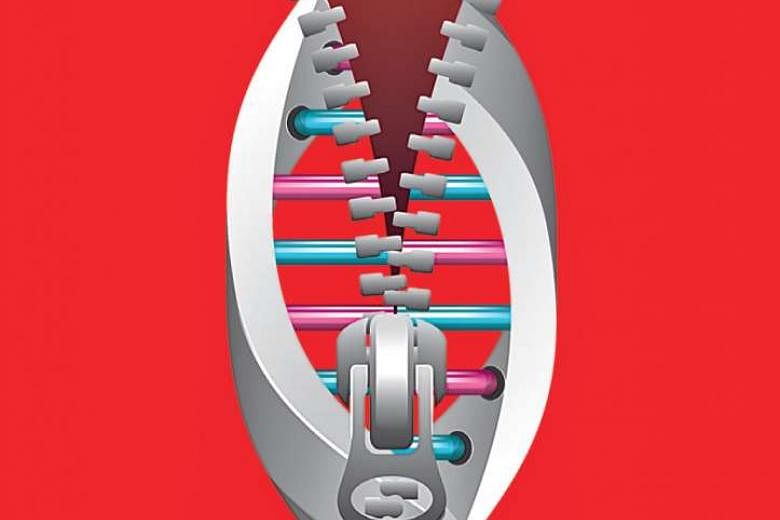I always keep a safety pin in my trusty coin pouch. It is because, like many other people, I have been caught in numerous zipper-malfunction situations.
Life is also dependent on a zipper-like function. Our DNA is neatly zipped up from two complementary strands. When a gene is needed, that portion of DNA is unzipped, transcribed and translated into proteins, which carry out the required functions.
DNA is made up of the A, G, C and T nucleotides.
The A nucleotide has two hands in the form of hydrogen bonds which pair in two handgrips with T, which also has two hands.
Similarly, G and C pair up to form three handgrips. Together, these millions of little handgrips hold up the two DNA strands as a continuous long zip.
Leukaemia is a genetic disease. Inside leukaemia cells, corrupted genes send out continuous signals to keep growing and crowding out normal blood cells.
To make another leukaemia cell, it needs to make a copy of all its genes. The DNA unzips; each strand is copied into a new one and packed into a new leukaemia cell.

The chemotherapy drug, mercaptopurine, was designed to exploit this zipper-like function. It is a fake G nucleotide with two hands, instead of three.
When mercaptopurine is incorporated into the DNA, the DNA zip malfunctions, making the whole DNA strand unstable and, eventually, it breaks down.
For leukaemia cells which are in a hurry to keep growing, they find it difficult to constantly repair this zip malfunction and they die.
CHOKING CANCER CELL PRODUCTION
Mercaptopurine is the cornerstone drug that treats children with leukaemia. Every night, for at least two years, my patients faithfully take mercaptopurine. It has caused cancer cells to slowly choke up the very machinery that drives them.
After two years, most of the leukaemia cells would have died, giving the kids a new lease of life.
When I started treating leukaemia patients, my mentor cautioned me that Asian children are more sensitive to mercaptopurine, tolerating only two-thirds of the usual dose.
I never knew why. Initially, I thought that Asians took less cow's milk, which contains an enzyme that digests the mercaptopurine.
Less cow's milk in the diet means more mercaptopurine, I surmised.
But, as a father of a three-year-old boy, I now know that is not true. My son gobbles up 10 ounces of milk before he sleeps and I am always happy to feed him more.
Some Caucasian children are sensitive to mercaptopurine, due to a variant in the TPMT1 gene that breaks down mercaptopurine.
But only 3 per cent of more than 1,000 Asian children tested had TPMT variants, compared to 40 per cent who are sensitive. So, the TPMT gene responsible for Caucasian children's sensitivity is not the answer.
In 2014, doctors at the Genome Institute of Singapore and St Jude Children's Research Hospital in the United States discovered variants in the NUDT152 gene, which are found only in Asians, that caused this sensitivity.
At the National University Cancer Institute, Singapore, we have collected years of patient data on mercaptopurine dose, blood and DNA to pave the way for this breakthrough. This is made possible with funds from the Children's Cancer Foundation and National Medical Research Council.
Together with St Jude's doctors, we have found that one in five of our children had variants in their NUDT15 gene. Three new variants were also discovered.
In addition, one in 80 children had exquisite sensitivity to mercaptopurine, tolerating only 10 per cent of the normal dose.
Belinda is one of them. She developed fever after just one week of mercaptopurine.
Through trial and error and with much trepidation, I reduced her mercaptopurine to the lowest possible dose of a quarter tablet every week instead of one tablet every night, as both of her NUDT15 genes are non-functional.
She was the only one among the 80 who was exquisitely sensitive to mercaptopurine and would have died from severe infection if she had been given normal doses.
With funding help from the Viva Foundation, Children's Cancer Foundation and the Tote Board, we now test for NUDT15 variants and start patients on genetically appropriate doses.
Mirelle, one of my teenage patients with two non-functional NUDT15 genes, was given low doses but still needed further reduction.
She weighs 60kg but takes only 2mg of mercaptopurine every night. In comparison, two of my infant patients, who weigh 10kg each, are taking 30mg doses.
Through research, we have found the reason our children are more sensitive to mercaptopurine.
This sensitivity is the Achilles' heel of leukaemia cells, giving us one of the best results in the world for leukaemia treatment, despite administering relatively low doses of chemotherapy.
We now focus on tailoring the correct dose of mercaptopurine using a rationally-guided treatment, in what is known as precision medicine.
Ironically, my embarrassing zipper malfunctions have been translated into cures for patients.
•Associate Professor Allen Yeoh is a senior consultant in the paediatric haematology-oncology division at the National University Cancer institute, Singapore, which is part of the National University Health System. He runs studies in leukaemia involving NUH, KK Women's and Children's Hospital, as well as Malaysian centres.

